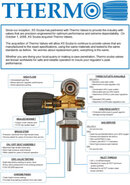- Messages
- 14,192
- Reaction score
- 11,457
- Location
- Port Orchard, Washington State
- # of dives
- 1000 - 2499
The isolation manifold for the Z-system is a needle valve, identical to the valves on your scuba tanks,
Scuba tanks do not use needle valves and I don't think the UTD manifold block is either. Both are fast opening nylon seat to orifice valves.
Needle valves are often used on O2 whips and such. The only underwater use I can think of is to adjust the O2 delivery rate on a mCCR when you can't used a fixed IP 1st stage and orifice because you want to go deeper than the IP of the reg (mid 200ft or so). You have to adjust the orifice as the IP changes with depth to maintain an appropriate O2 mass flow rate, very fine scale changes which is what needle valves are good at.




